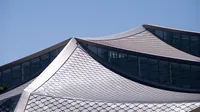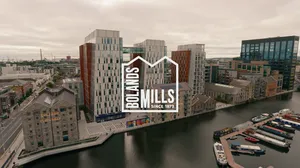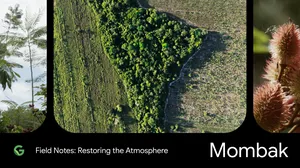Dragonscale: a beautiful approach to solar

Earlier this year, we shared our plans for ‘dragonscale’ solar skin — a first-of-its kind design made up of 90,000 silver solar panels with the capacity to generate nearly 7 megawatts of energy.
To hit our goal to operate on entirely carbon-free energy by 2030, we need to prioritize alternate sources of energy, like solar, and maximize the amount of solar energy our buildings can capture. So when the designs for our newest additions to our Silicon Valley campus evolved into a large, canopy structure, we knew we’d have to think beyond traditional rectangular solar panels to create something that balanced form and function. Today, the two main developments that have this solar roof, Bay View and Charleston East, are nearly complete.
Enter the ‘dragonscale’ solar roof
As the person responsible for looking at sustainable systems design for our real estate developments, I helped lead the efforts to engineer this new solar panel design for Charleston East and Bay View. Over the course of this project, I’ve watched these designs turn from an idea into reality.
The dragonscale solar roof that will adorn these buildings is the result of years of product development, collaboration with a handful of partners, and examining prototypes from manufacturers all over Europe. It wasn’t easy. At one point my 7-year-old son even jumped in to help with his own design concept.
Design suggestion from Asim Tahir’s son.

Eventually, our partners at SunStyle came to us with a highly textured prismatic glass shingle with a unique coating technology. The prismatic nature of the glass ‘trapped’ light that would normally escape from traditional flat solar panels and reduced reflective glare that can be a problem for drivers and pilots. That same texture that provides all that function, also gives the overlapping panels a unique sparkle that earned it its name ‘dragonscale’.
These panels coupled with the pavilion-like rooflines let us capture the power of the sun from multiple angles. Unlike a flat roof, which generates peak power at the same time of the day, our dragonscale solar skin will generate power during an extended amount of daylight hours. This will limit our contribution to California’s notorious duck curve — which tracks the difference between energy demand and the available solar energy throughout the day. When up-and-running, Charleston East and Bay View will have about 7 megawatts of installed renewable power—generating roughly 40% of their energy needs.
Shortly after construction began, we couldn’t help but think about how we might make this form-and-function approach to building design more scalable. After all, we can’t custom design and develop a new solar solution for every project.
The construction team installs BIPV at Google’s Bay View office development. Photo by Christopher Mcanneny, Heatherwick Studio.

Going mainstream with learnings from dragonscale
Solar panels that are integrated into the design of the building, rather than added later, are known as building-integrated photovoltaics (BIPV). Integrating solar panels into a roof, like we did with dragonscale, is one approach to using BIPV. Another is incorporating them into the skin of the building. But again, the challenge is to do it in a way that looks good.
The constraints of traditional manufacturing processes also make BIPV projects more difficult. Currently, buildings featuring integrated solar panels require custom designed and manufactured panels, which only niche producers using flexible manufacturing processes with limited output can produce. For our newer buildings, we chose to use a standard solar panel size (3 feet by 5 feet) with standard panel mounts in our designs. This allowed us to use more prevalent, high-volume manufacturing processes so that production and installation could ramp up quickly and at scale.
In a relatively short amount of time, we were able to work with different manufacturers, experiment with a range of facade aesthetics, land on a few designs and share them with our construction teams. Today, two of our newer projects in the Bay Area are implementing these facade photovoltaic panels.
Two examples at our R+D Lab of exploring how to add photovoltaics on facades: rearranging standard solar panels into more visually interesting mosaics (left) and integrating solar into standard window framing (right).

Investing in sustainable energy innovations will not only get us closer to our goal to be carbon free by 2030, but it will also help our partners and others get there. We hope that sharing our approach to blending design, aesthetics and manufacturing will inspire more projects like it.







